Twenty minds turn art on its head, choosing to use not pictures, but text to discuss urban alienation, gender inequality and consumerism
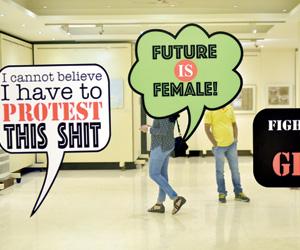
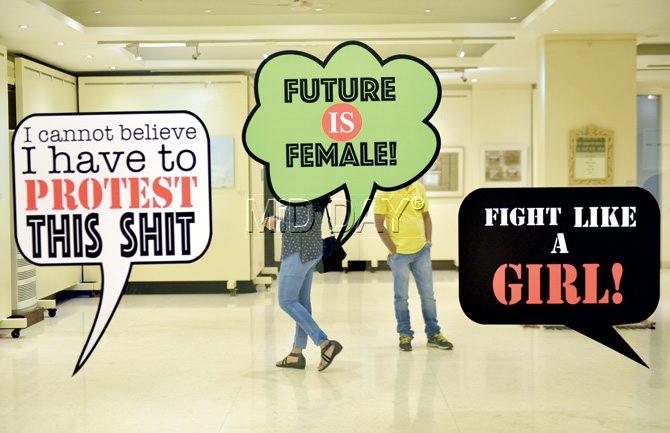
Vidya Kamat's collage of women's protest slogans seen in the Text as Text series. They fit into Kamat's series on multi-lingual slogans that articulate women's anger, frustration, defiance and rebellion.
 Don't tell me not to go out, tell HIM not to rape; Kapde nahi, soch badlo (Not clothes, change your mindset); Mazhe shareer, mazha hakka! (My body, my right) — this is no mere sampling of protest slogans but a wall poster series titled, She Said, by artist Vidya Kamat. She has zeroed in on 80-odd multi-lingual women's slogans that carry an expression of anger, frustration, defiance and rebellion. Of these, three key ones have found their way to Text as Text, an ongoing group show at Worli's Art and Soul gallery.
Don't tell me not to go out, tell HIM not to rape; Kapde nahi, soch badlo (Not clothes, change your mindset); Mazhe shareer, mazha hakka! (My body, my right) — this is no mere sampling of protest slogans but a wall poster series titled, She Said, by artist Vidya Kamat. She has zeroed in on 80-odd multi-lingual women's slogans that carry an expression of anger, frustration, defiance and rebellion. Of these, three key ones have found their way to Text as Text, an ongoing group show at Worli's Art and Soul gallery.
ADVERTISEMENT
Kamat's mega-size speech bubbles on vinyl that celebrate the 'fight like a girl' sentiment fit well in the larger collection of pithy texts mounted by 20 artists whose capture of contemporary angst is thought-provoking. It is pure coincidence that the text-based visuals — paintings, hand drawn books, photos printed on canvas, lithographs or hand painted posters and placards — are up for an exhibition-cum-sale at a central Mumbai, blue collar neighbourhood from where once bloomed several grassroots women's groups and labour unions, which in turn thrived on defining slogans and refrains.
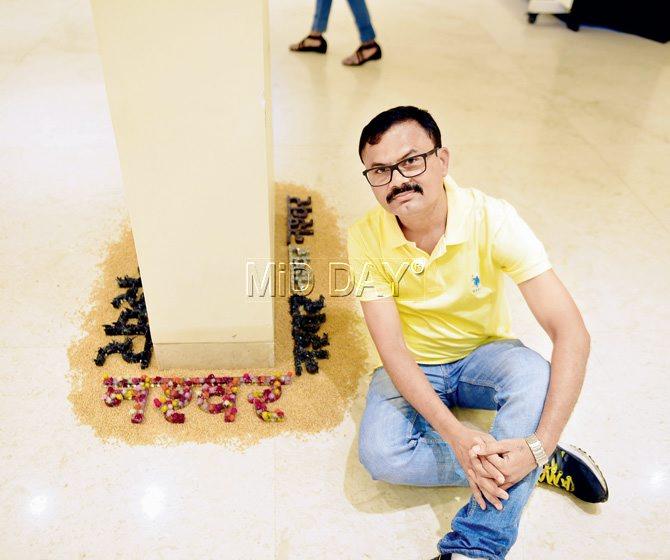
Artist Lalit Patil seen with his iconic installation of the Hindi word Nashwar (mortal) in which he has recycled rusted iron left-overs and manually segregated ornate metal cut-outs to underline impermanence. Pics/Bipin Kokate
Credit is due to curator Shubhalakshmi Shukla for the assemblage of 61 text-based artworks, like Kim Kyoung-ae and Gayatri Gamuz. While Kyoung-ae is of Korean origin and has made Baroda her home, Gamuz is a Spanish woman settled in Thiruvannamalai. The artists believe in the use of text as a radical response to everyday realities, whether loss of roots, consumerism, class conflict or gender injustice. Mumbai-based Shukla, 49, is the author of Imagined Locales: Contemporary Indian Arts. She feels that ample space should be created to showcase similar work, which is why she wants to extend the theme beyond the first exhibition. She is busy working on the second edition of this project which looks at the repetition of same or similar sounding words in the contemporary context. The art works will factor in the Bollywood fixation with reiteration too. The third edition will focus on broken, scattered and forgotten words, along with an exploration of the lost text. Shukla, who studied painting at Viswabharati University in Santiniketan and is a post-graduate in art history from MS University, Baroda, says that text compels a surefire response from the viewer, just as it did with the works of Yoko Ono (Listen to the Sound of The Earth Turning), Barbara Kruger (I shop therefore I am), Jenny Holzer (Protect me from what I want) and Anita Dube (Strike, Silence).
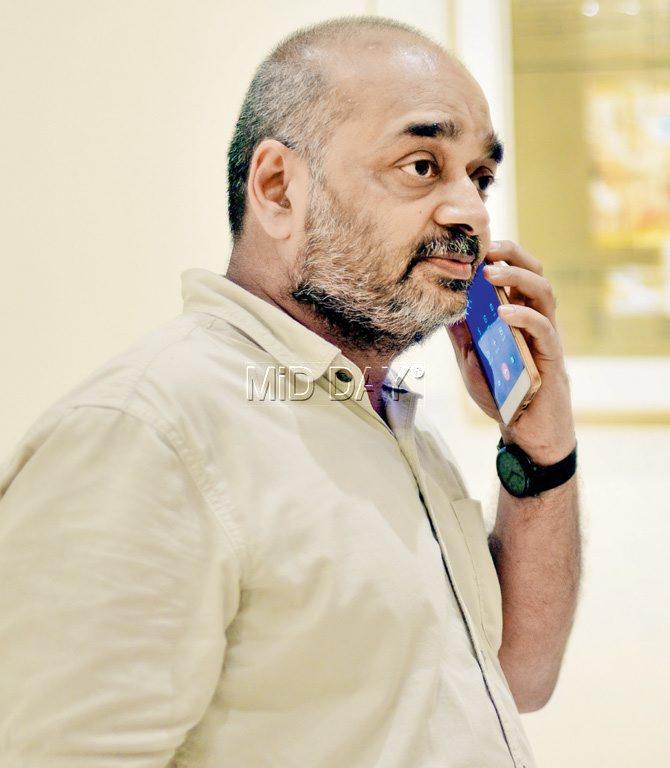
The presentation Disoriented Existence by Artist Sudhir Pandey
Shukla's conviction on the power of text comes through clearly in Sanjeev Sonpimpare's work, Nation /State/ Citizen. It's a creative crisscross of government schemes on the reverse of a canvas. Resembling a wired net, or a cubic construct, the maze of 40 names of government schemes makes you wonder about the various well-meaning initiatives launched for the common man: Atal Pension Yojana, Swachh Bharat Abhiyan, Rajiv Gandhi Jeevandayi Arogya Yojana, Pradhan Mantri Sukanya Samriddhi Yojana... Without saying much on the worth of the initiatives, Sonpimpare, a JJ School of Art alumnus, underlines the bureaucracy of a welfare state. His grid points out the difficulty faced by scheme beneficiaries to claim what's theirs. His other text-heavy series titled Respite makes an intelligent use of black moong daal (punning on the Hindi adage, Daal mein kuch kaala hai) to underscore the fishy corruption in high offices, which starts from Babu Chaprasi and moves to the sarpanch to the nagarsevak and finally to the mantri.
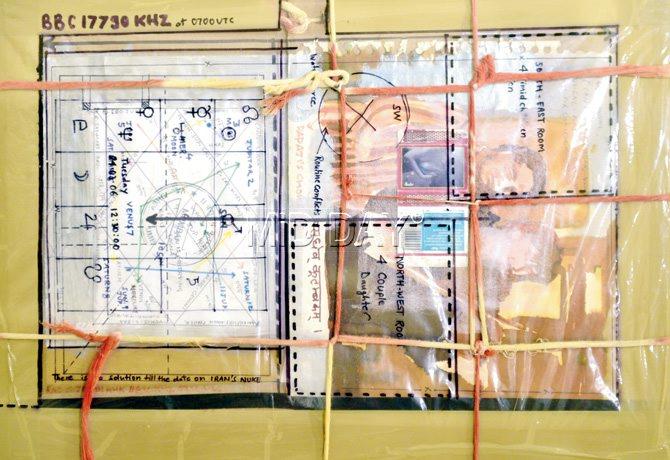
Makes use of mud, radioactive wrappings, wire and ritual thread to evoke a vanished past
Sudhir Pandey explores the loss of one's roots in Disoriented Existence. Here, he puts together mud, radioactive wrappings, wire and ritual thread to evoke a vanished past. The artist from Mandsaur in Madhya Pradesh says he has small-town memories of indulging in Ham shortwave radio. "I feel all objects, regardless of shape or size, utility or luxury, have their rightful existence and destiny. They influence our collective identity." Some of Pandey's text speaks clearly against regionalism, corresponding with his own experience of xenophobia in Mumbai. Lines like Mee Marathi nahin pan mee manavi aahe; Hun Gujarati nathi, parantu hun manav chhoon say that people are human before they are anything else.
Kiyomi Talaulicar's twin frames, Hope Whispers I — II are texts in Braille, which the artist has chosen not to frame. It's text you must experience. "The tactile dimension to the text comes out strongly, and it exudes hope as per the title," says the artist.
Artist working with several media Bharati Kapadia's L FOR… is an interactive spoken word poetry video performed in sign language as well as animation. The artist follows the A FOR APPLE phonics strategy, in which children are taught alphabet shapes and sounds, only to underline how love cannot be contained within the linear, simplistic, one-dimensional mode that the strategy uses. By taking us on an "expedition across four letters", she reminds us of the nuance associated with love in today's times.
Lalit Patil's 3x6 feet installation repeats the Hindi word Nashwar (mortal) using recycled rusted iron left-overs and manually segregated ornate metal cut-outs.
Impermanence is the word, and the text says it all.
Sumedha Raikar-Mhatre is a culture columnist is search of the sub-text. You can reach her at sumedha.raikar@gmail.com
 Subscribe today by clicking the link and stay updated with the latest news!" Click here!
Subscribe today by clicking the link and stay updated with the latest news!" Click here!







